AW1 Thomas W. Hayes, U.S. Navy Reserve (Retired) – Three Rescues in Two Days
Navy sailors train over and over so they are prepared to do their jobs under any circumstances. Be it peacetime or war, they must be ready to accomplish their missions even at the risk of their own lives. Aviation Anti-Submarine Warfare Operator 1st Class Thomas W. Hayes, U.S. Navy Reserve (Retired), trained as a search and rescue swimmer and deployed aboard aircraft carriers in case he was needed to save downed aircrew from the ocean’s icy waters. Because of his efforts, three aviators lived to fly again another day. This is his story.
Tom was born in November 1953 in Highland Park, Michigan. His father settled there after his hitch in the Air Force during the Korean War, although the family eventually put down permanent roots in East Detroit. Tom and his two younger sisters attended East Detroit High School, a huge school enrolling 3600 students in the top three grades. Tom found his niche in the choir, which he sang with all three years and served as the choir president during his senior year. He also worked at Chatham’s grocery store to keep some spending money in his pockets, but the real headline from his time at high school was he started dating his future wife, Regina Marie Laesch, during his senior year.
Tom graduated from East Detroit High School during the spring of 1972 and began working full time at Chatham’s grocery store as part of the night crew stocking shelves. His mom wanted him to go to college, but Tom knew he wasn’t ready. What he was ready for was getting married, which he and Regina did in 1975. By the summer of 1976, Tom knew he needed more than a career at the grocery store. He discussed his thoughts with Regina and asked her if she would be okay with him joining the military. When she gave him the green light, he headed for the nearest Armed Forces Recruiting Station to see what the military had to offer.
The recruiting station had recruiters from all four services, so Tom decided to talk to the Marines first. He asked the sharp-looking Marine gunnery sergeant (“gunny”) what the Marines could do for him. The gunny stood up and told him he would get to wear the Marine uniform. Tom was looking for more than that, so he made his way to the Navy. Admittedly, the Navy had a leg up on the other services before Tom even walked into the recruiting station. That’s because when Tom was a boy, his family visited a Navy ship tied up along the Detroit River. When the ship got underway for family day, Tom went along because one of the ship’s petty officers was a family friend and they let Tom steer the ship. As if that experience wasn’t enough, the Navy recruiter was a high school classmate of Tom’s. He had joined the Navy right after graduation and was now back in Detroit on recruiting duty.
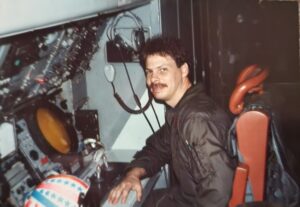
The recruiter asked Tom what he wanted to do if he joined and Tom said he would love to fly. The recruiter told him the Navy had just the job for him – an Aviation Anti-Submarine Warfare Operator or “AW”. He told Tom if he became an AW, he could serve on the big four-engine anti-submarine aircraft known as the P-3 “Orion” and he would never have to serve on a ship. That was music to Tom’s ears because avoiding long periods away from home while deployed on a ship would work best for him and Regina. He told the recruiter if he could make him an AW, he was in.
To seal the deal, Tom passed the initial physical exam and took the Armed Services Vocational Aptitude Battery (ASVAB), a prerequisite to enlisting. After processing the results, the recruiter informed Tom he could not get him the AW job they had discussed, but he could make him an Operations Specialist (OS). Knowing that meant extended time at sea on ships, Tom told the recruiter since he could not make Tom an AW, he was no longer interested in enlisting. The recruiter told Tom to give him fifteen minutes and he disappeared. He returned at the end of the time period and told Tom he’d gotten him the AW job after all. That was all Tom needed to hear and he enlisted in the Delayed Entry Program with an active duty report date of September 22, 1976.
When September 22 arrived, Tom and approximately thirty other new recruits reported as ordered. They were escorted to the train station for the trip to boot camp. As they waited for the train, a Navy petty officer handed Tom a folder with everyone’s name in it. He told Tom since he was the oldest recruit, he was in charge and responsible for making sure everyone arrived safely at Naval Station Great Lakes for boot camp. His Navy career had officially begun.
Tom succeeded at his first tasking as everyone was accounted for when the train arrived at Union Station in Chicago late in the evening. Then they were all herded onto a bus for the final leg of the journey to Naval Station Great Lakes, located about an hour north of Chicago. They arrived early on the morning on September 23 and “hell broke out right away” as the transition from civilian to sailor began.
Tom felt prepared for the ordeal because his father had given him an idea of what to expect upon arrival. Above all else, he told Tom never to volunteer for anything. This rang true when the company commander asked for volunteers to drive his Cadillac. Hands shot up and the company commander selected his volunteers. The chosen few were all smiles until they learned the company commander’s Cadillac was a bucket of water on wheels with a mop for swabbing floors.
Although Tom dodged that bullet, he could not avoid being designated as the Recruit Chief Petty Officer, or “RPOC”, after the recruit in the position before him lost the job for being a jerk. As the RPOC, Tom called the cadence when the company marched around the base between training events and to chow. He also served as the Recruit Division Commander’s primary assistant, responsible for keeping everyone in the company in line. As for Tom’s predecessor, he got what he deserved for being a jerk. As the company marched to the chow hall one afternoon, the jerk and his friend were both targeted by a seagull. With pinpoint accuracy, the seagull dropped a bomb that splattered on both recruits at the same time. Tom describes the event as karma in action.
After graduating from boot camp two weeks before Christmas in 1976, Tom reported to Naval Air Station Memphis for AW “A” school. There he learned the basics of being an Aviation Anti-Submarine Warfare Operator. He also had to pass the Class II swim test. Tom did well in the classroom part of the training, but he especially excelled at swimming because he’d been a swimmer all his life and was already a certified lifeguard and diver. A Navy SEAL chief petty officer administered the swim test and, after he saw Tom swim, took him aside and said, “Son, you’re going to the fleet. They really need swimmers.”
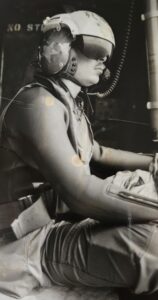
The SEAL chief’s evaluation completely changed Tom’s trajectory. Instead of heading to P-3 ASW patrol aircraft operating only from Navy airfields ashore, now he would be an aircrewman on the SH-3 Sea King helicopter getting underway on ships for long periods away from home. It also meant he would train to be a rescue swimmer, ready to jump from helicopters into the ocean to pluck downed pilots from the water before they drowned.
Tom’s training as an SH-3 helicopter aircrewman began immediately after AW “A” school. First, he spent five weeks attending Search and Rescue (SAR) swimmer school in Jacksonville, Florida. There he learned basic first aid, practiced treading water for long periods, and built his endurance through constant physical training. He also learned skills like getting someone out of a parachute while in the water and rescuing a combative swimmer. For his final exam, he had to jump into a disaster situation where five or six people needed to be rescued. He had to assess each person’s situation, prioritize their rescue, and then use the appropriate technique to successfully rescue each person. The final test kept him working in the water for a full forty-five minutes, but when he emerged, he was a qualified SAR swimmer.
Tom next reported to Survival, Evasion, Resistance, and Escape (SERE) school at Naval Air Station Brunswick, Maine. He spent a week and a half there learning what to do in the event he was ever captured by enemy forces. Although Tom was an experienced outdoorsman because he had gone camping with his father growing up, the entire experience proved a challenge. He was glad when it was over.
After SERE school, Tom reported to HS-1, the SH-3 Sea King helicopter Readiness Air Group (RAG), onboard Naval Air Station Jacksonville. All newly arriving SH-3 enlisted aircrew and officer pilots on the East Coast received their final training there before reporting to a fleet SH-3 helicopter squadron. At HS-1, Tom got his first taste of flying as an aircrewman in a helicopter, accumulating twenty-five hours of flying time. He obtained additional training hours in an SH-3 simulator, but by the time it came time to transfer to an operational squadron in the fleet, he had yet to jump out of a helicopter to conduct a practice rescue.
The reason Tom did not get to conduct a practice jump was because the fleet really needed rescue swimmers. To meet the demand, HS-1 condensed Tom’s training timeline and sent him off to his first permanent duty assignment at HS-15, a fleet SH-3 squadron also located onboard Naval Air Station Jacksonville. This worked out well because he had previously moved Regina to Jacksonville while he was in SAR school. They purchased a mobile home near the base and prepared to welcome their first child in early 1978. Before that, though, the HS-15 “Red Lions” had plans for Tom that would take him far from home.
Those plans involved the squadron and all its personnel, including Tom, deploying on the aircraft carrier USS America (CV-66) on September 29, 1977. Once the ship got underway on the cruise, Tom took his turn working in the ship’s main galley “mess cranking”, doing duties necessary to help feed the America’s 5,000 crewmembers, but the usual six-week assignment for new sailors was reduced to two weeks because the ship needed his skills as a SAR swimmer more than it needed him to wash dishes.
The America put Tom’s skills to the test one night in November 1977 when the ship was conducting flight operations in the Mediterranean Sea. While Tom was flying on an SH-3 conducting a night ASW mission in the vicinity of the aircraft carrier, an F-14 “Tomcat” jet fighter, made famous in the 1986 film Top Gun starring Tom Cruise, tried to land on the ship’s flight deck. The plane’s tailhook caught the arresting wire but the wire failed. Both the pilot and the radar intercept officer (RIO) ejected from the plane before it went over the side, with both men landing in the calm but pitch-black water.
Immediately, the ship put out the call “two men in the water.” Without waiting for direction, Tom took off his helmet and put on his wet suit as the helicopter’s pilot maneuvered the SH-3 to the area where the two men might be. Soon they saw a pencil flair launched from one of the downed crewmembers and the SH-3’s pilot positioned the helicopter for the rescue.
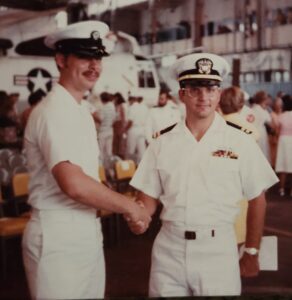
Because it was dark, Tom could not see if there was any debris from the F-14 in the water, making it unsafe to jump in. Accordingly, he grabbed onto the helicopter’s rescue hook and was lowered into the water. He then swam to the waiting RIO, Lieutenant Stampe. Just as he had been trained, Tom freed the lieutenant from his parachute and attached him to the rescue hook so he could be lifted into the helicopter. After Lieutenant Stampe was safely onboard, it was Tom’s turn. Then the helicopter flew them both back to the America, where they were checked by medical and found to be in good health. The F-14 pilot was also fine, having been rescued by the SAR swimmer from the SH-3 flying plane guard (the helicopter whose job it was to be ready to rescue downed aircrew during flight operations). For his part in the successful rescue, Tom was awarded a ceremonial shot of brandy. He was also a hero to Lieutenant Stampe’s F-14 squadron, the VF-142 “Ghostriders”.
Less than twenty-four hours later, an EA-6B “Prowler” electronic warfare plane’s jet engines flamed out during its landing approach, causing all three crewmembers to eject into the water. Again, Tom was nearby on an ASW mission in an SH-3 and the pilot moved in for the rescue. Although it was daylight, eighteen to twenty-foot waves made the rescue perilous. As on the previous day, Tom donned his wetsuit and then jumped into the ocean to rescue one of the downed airmen. Despite the high seas, the rescue went perfectly and soon the downed airman and Tom were back in the helicopter. The surprise came when the helicopter’s other aircrewman told him there was another aviator in the water and they had to get him, too.
Tom positioned himself in the door of the helicopter, getting ready to time his jump so he’d land in the crest of a wave. Suddenly, a giant rogue wave came in and the pilot said “whoa!” over the intercom. The helicopter’s other aircrewman thought the pilot said “go” and gave Tom a shove, launching him out of the helicopter. The timing of the shove couldn’t have been worse. Instead of falling a short distance to the crest of the wave, Tom fell sixty feet into the trough making a hard landing. Shaken but uninjured, he swam to the downed aviator and helped the helicopter safely extract him from the water. Soon, the two EA-6B aircrew he rescued joined the one rescued by the plane guard helicopter on the ship and all were cleared by medical. Again, Tom enjoyed his ceremonial brandy. He was also awarded the Navy and Marine Corps Medal for heroism as a result of all three of his rescues. One of Tom’s fellow SAR swimmers remarked he’d been a SAR swimmer for five years and never made a rescue, whereas Tom had been a SAR swimmer for only a few months and had already made three in just two days.
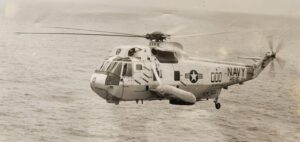
From a SAR rescue perspective, the rest of the cruise was uneventful. In December, however, Tom learned Regina was having complications with her pregnancy, so he rushed back to Jacksonville to be with her. Fortunately, on January 3, 1978, Regina gave birth to a healthy baby girl, Shanna. With both mother and daughter doing well, Tom had to head back to ship, which he did via Norfolk, Virginia, where he waited for a flight to Italy. In the meantime, he was assigned to shore patrol, escorting sailors who’d gotten into trouble to their disciplinary hearings and courts-martial. After he caught his flight, he rejoined the America in Genoa, Italy. He flew on ASW and plane guard missions on SH-3s for the rest of the cruise and sailed back with the ship to Norfolk in late April 1978 at the end of the seven-month deployment.
Tom and the rest of HS-15 got some well-deserved rest at Naval Air Station Jacksonville, Florida, after the deployment. In addition to spending time with Regina and Shanna, Tom made several trips with his squadron to the Atlantic Undersea Test and Evaluation Center (AUTEC) range in the Bahamas, where the helicopter crews practiced their anti-submarine warfare skills and snuck in some snorkeling time in the beautiful waters around the islands. Soon, though, it came time to begin workups for the next long deployment, this time aboard the aircraft carrier USS Independence (CV-63).
Workups for the USS Independence cruise meant training off the east coast of the United States and in the Caribbean to hone everyone’s skills before heading to the Mediterranean Sea. During the Caribbean training, the USS Independence anchored at Naval Station Guantanamo Bay, Cuba. As this was the height of the Cold War, tensions were always high. So, when “General Quarters, General Quarters – this is not a drill” sounded over the 1MC (the ship’s internal communication system), Tom and everyone else feared the worst. By the time Tom made it to his battle station on the flight deck, though, he learned the reason for the alarm was a fire in one of the ship’s generators. The fire was quickly resolved, and the Independence departed Guantanamo Bay on schedule.
HS-15 and Tom deployed aboard USS Independence to the Mediterranean Sea on June 28, 1979, shortly after Regina gave birth in May to their second child, Thomas. Aside from fascinating port calls in Athens, Greece, and Haifa, Israel, where Tom took tours of various ancient world sites, the deployment was uneventful. He returned with the ship to the United States on December 14, 1979.
After his deployment on USS Independence, Tom made the difficult decision not to reenlist. His original plan for the Navy had been to be part of a P-3 aircrew so he would not have to deploy onboard ships. Instead, he’d already completed two full deployments plus all the related at-sea workup time within the space of three years. So much time away from his young family was tough on everyone, so he and Regina thought it best to tell the Navy goodbye. Accordingly, in September 1980, Tom was honorably discharged from active duty and the family returned to East Detroit.
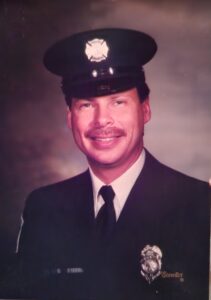
Fortunately for Tom, his job at Chatham’s grocery store was waiting for him when he arrived back in East Detroit. This gave him the immediate income he needed to keep his family afloat, but it wasn’t what he was looking for long term. Instead, he set his sights on becoming a fire fighter and began taking classes at nearby Macomb Community College to earn his EMT certification. He also completed firefighter training and worked for the city of East Detroit as a paid-on-call firefighter, which meant he only got paid for the hours he spent fighting fires. This was a prerequisite to becoming a full-time firefighter, which he did for the city of East Detroit in 1983.
Tom also missed his time in the Navy and by coincidence, there was a Navy Reserve P-3 squadron (VP-93) operating just fifteen minutes away at Naval Air Facility Detroit onboard Selfridge Air National Guard Base. The squadron was a perfect fit, offering exactly what Tom enlisted for back in 1976. He would serve as a radar operator on a P-3 with a commitment to drill one weekend each month and two weeks each year. That schedule worked for Regina, too, so Tom enlisted in the Reserves as an Aviation Anti-Submarine Warfare Operator Petty Officer 2nd Class (abbreviated as AW2).
Until Tom became a full-time firefighter, his schedule remained challenging. He worked full-time at Chatham’s grocery store, served as a paid-on-call firefighter for East Detroit, and trained and drilled for his radar operator position at VP-93. He especially enjoyed his time at VP-93 because his shipmates were professionals in every sense of the word and they formed a close-knit group. While part of VP-93, Tom flew on P-3 flights conducting Cold War missions to detect and track Soviet submarines. He also flew on missions supporting the interdiction of drug smugglers in the Caribbean and participated in operations involving Haiti and the former Yugoslavia.
Tom would have stayed at VP-93 forever, but in 1993 the squadron was decommissioned as part of the Base Realignment and Closure Commission (BRACC). Afterwards, he did a short stint with the Barbers Point ASROC (anti-submarine rocket) Augmentation Unit but was bored because it involved mostly classroom work. He then learned another Reserve P-3 squadron, VP-64 out of Naval Air Station Willow Grove in Pennsylvania, could use his radar operator skills. He agreed provided the squadron could send a plane to pick him up for his monthly drills, which it did because it had also enlisted the services of other VP-93 sailors in Michigan now in need of a Reserve home.
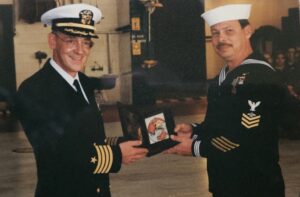
Although Tom enjoyed the missions he participated in with VP-64, including a trip to Scotland, he missed the comradery of VP-93. Accordingly, when VP-64 couldn’t guarantee he’d promote to chief even though he was an experienced first class petty officer and had already passed the chief’s exam, he decided it was time to retire from the Navy. He did so in October 1997 after completing over twenty years of distinguished active duty and Reserve service.
Now a civilian, Tom continued with his career as a firefighter for the city of East Detroit, which changed its name to Eastpointe in 1992. He retired a captain in 2011 after thirty years. For the last seven of those years, and extending through 2019, he also served as a rescue diver jumping out of helicopters to save offshore racers after their high-speed boats were involved in accidents. He made his last rescue jump in 2017 at the age of sixty-four.
In 2019, Tom and Regina attended a reunion of those who had served aboard USS America. The reunion was held in Virginia Beach and one of the events involved a visit to the Military Aviation Museum. When Tom and Regina’s bus pulled up to the museum, which includes an operational airfield so the vintage aircraft can fly demonstration flights, two docents came aboard. One asked if anyone on the bus was on the America’s 1977 Mediterranean cruise. After Tom and some other people raised their hands, the docent asked if they remembered the F-14 that went over the side after the arresting wire broke. Tom responded, “Yeah, and I’m the guy who picked up the RIO, a Lieutenant Stampe.” The docent then pointed to himself and said that was him.
Tom and Regina are now retired in Eastpointe, Michigan. They enjoy spending time with Shanna and Thomas and their children, who all live within a day’s drive. Tom also enjoys working part time and playing golf, and is active in the Red Knights Firefighters Motorcycle Club of Michigan.
Voices to Veterans is proud to salute Aviation Anti-Submarine Warfare Operator 1st Class Thomas W. Hayes, U.S. Navy Reserve (Retired), for his many years of dedicated service to our country. Early in his career, he made two deployments to the Mediterranean Sea, repeatedly risking his life to rescue downed aircrew. He then spent the remainder of his career patrolling the oceans for Soviet submarines and interdicting drug smugglers trying to gain access to our shores. For all he has done, and for all he and his family sacrificed on our behalf, we wish him fair winds and following seas.
If you enjoyed Tom’s story, please sign up for the Voices to Veterans Spotlight monthly newsletter by clicking here. Once each month, you’ll receive a new written veteran’s story directly in your mailbox. Best of all, it’s free and you can unsubscribe at any time.
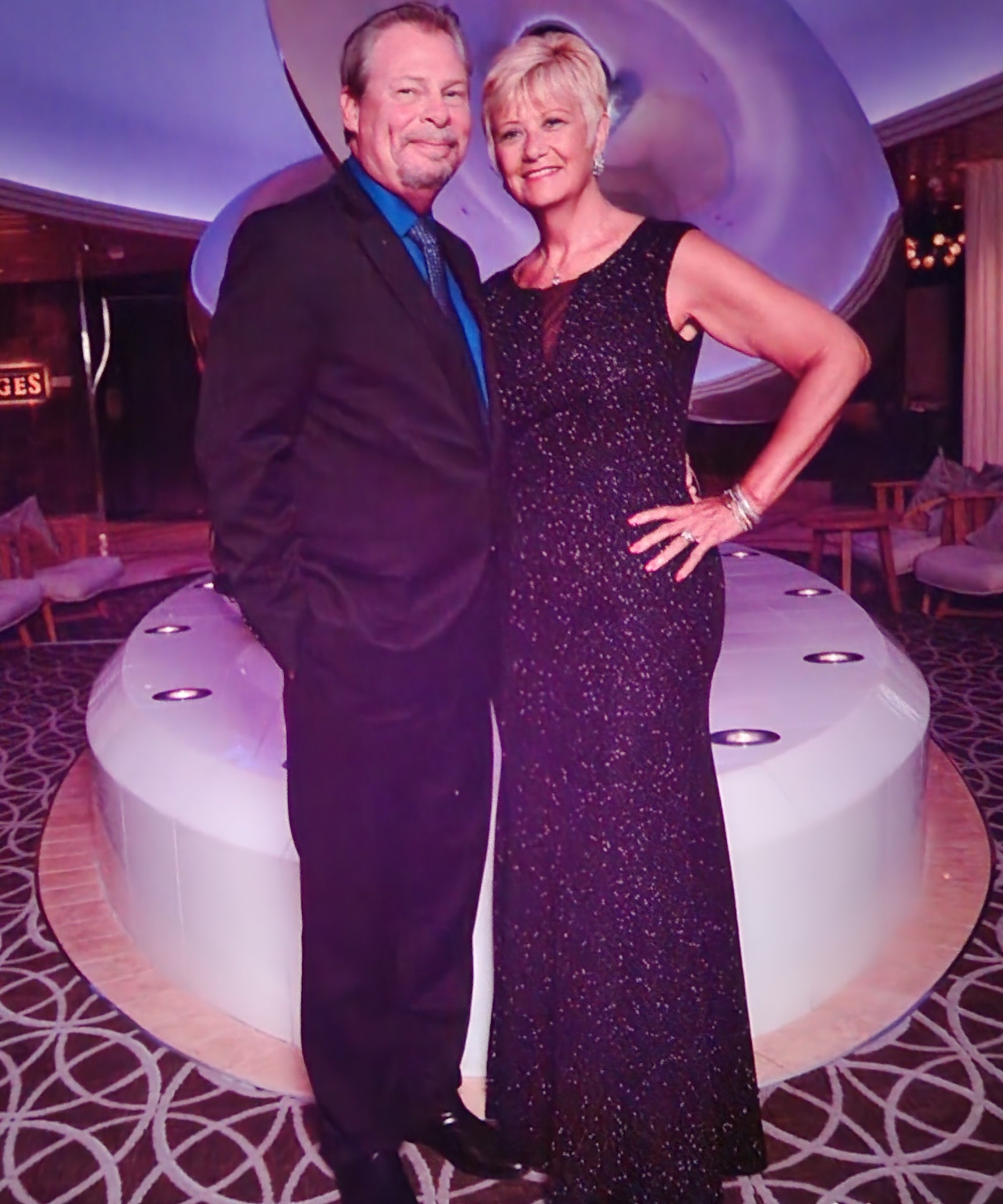

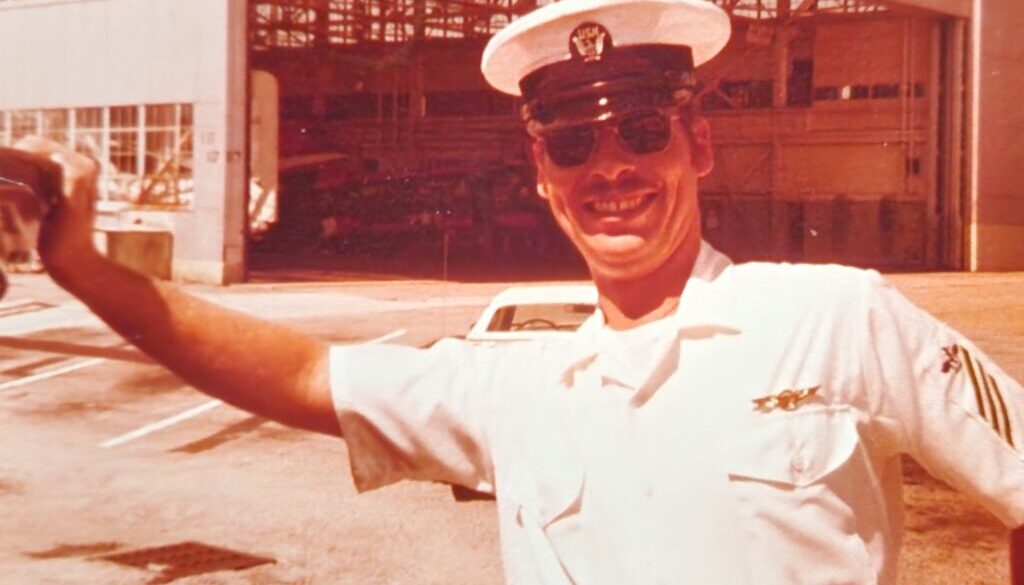
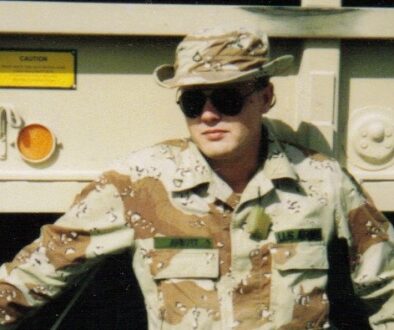

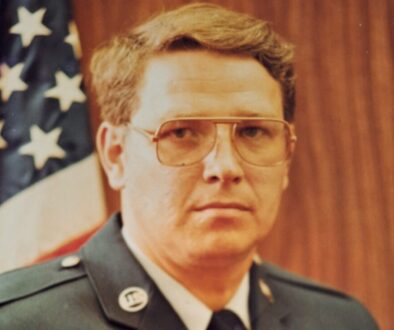
November 7, 2024 @ 11:56 PM
Tom Hayes’ first rescue was me, i was working at Chatham’s market when the company canceled the scholarship program I was in as the Detroit Economy was tanking. I did a 6 year enlistment in advance avionics based on Tom’s recommendation. It turned out great, I was a AT1 when my enlistment ended and completed a Bachelors of Science Degree. I was hired by GDLS in Warren MI, right next door to Eastpointe MI. I then enjoyed 32 years supporting the US Army from Field Service Representative in Weat Germany to Abrams Tank Program Director from 2004 through 2012. Some amazing times.
November 8, 2024 @ 12:52 PM
William – Thanks for reading Tom’s story and for leaving such a great comment. It sounds like you’ve got a great story as well. If you’d like to get it documented like Tom did (there is no cost), just let me know. I’ll also be sure Tom sees your comment. V/r, Dave Grogan